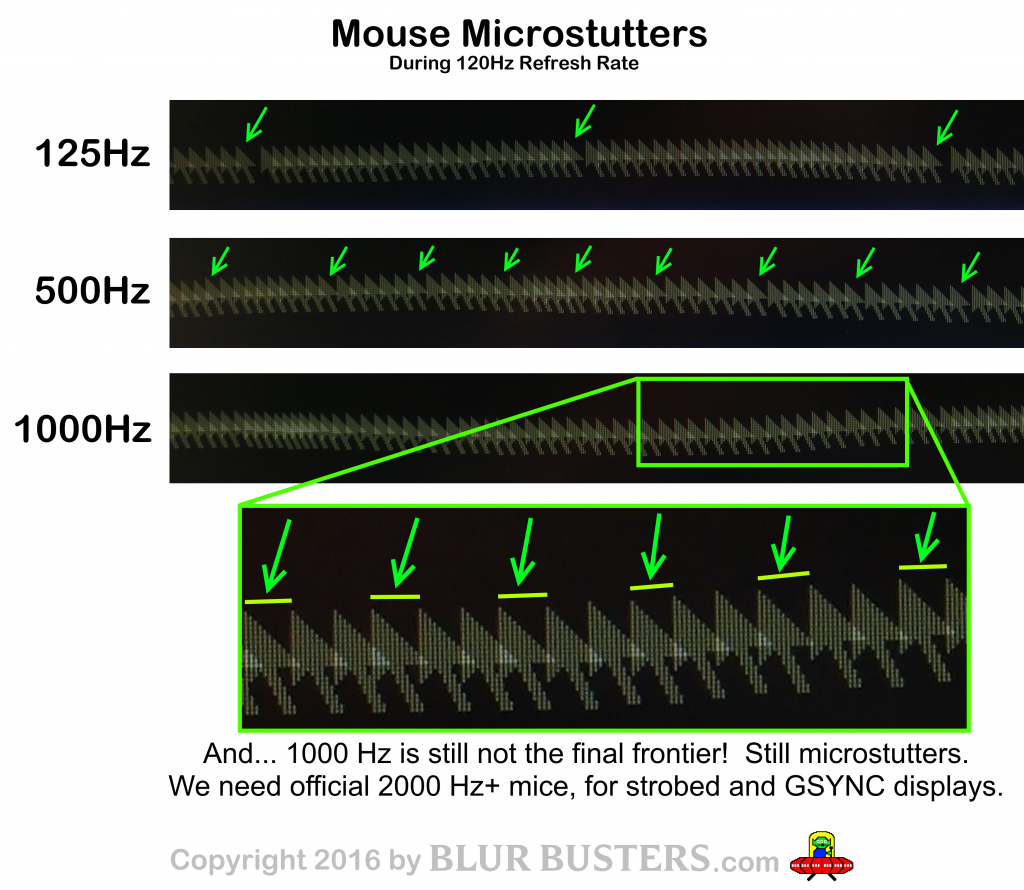Kosti wrote: ↑21 Apr 2020, 18:21
A question regarding my mouse:
I have a Finalmouse Ultralight 2 which runs at 500 Hz. I could overclock it to 1000 Hz but then i'm afraid of damaging the mouse (which you can't buy anymore) in the long run. Do you or others have any experience with this?
I always set my mice to 1600 dpi which is enough i think?
1000 Hz poll rate won't damage your mouse. Not sure how well Finalmouse will work with 1000 Hz though.
One problem is that monitor refresh rates are starting to approach display refresh rates. This amplifies harmonic / beat-frequency microstuttering effects between poll Hz / internal sensor Hz versus the refresh rate. This is normally not a problem in most cases, but sometimes it becomes human visible, especially for VSYNC ON motion situations:
From the
Blur Busters Mouse Guide...

The
Vicious Cycle Effect will eventually force mouse manufacturers to seriously consider 2000 Hz and 4000 Hz mice officially, especially if future 360 Hz and 480 Hz monitors start creating beat frequencies not seen before (e.g. 480Hz MOD 500Hz = 20 microstutters per second).
Now, the internal sensor readout rate may be much higher -- e.g. 6000 Hz internally -- which will allow a bit of more flexibility in 500 Hz polls. However, as seen in these photos -- it is quite blatantly clear that mouse Hz can be a microstuttering limiting factor, especially during fps=Hz motion (Windows, VSYNC ON, RTSS Scanline Sync, RTSS microsecond-accurate framerate cap, etc) where beat frequencies can emerge between mouse Hz and display Hz. This is not always visible -- especially for non-strobed motion -- but again, lack of motion blur amplifies the visibility of microstuttering.
Now, people have a favourite mouse that they are used to, and they are used to their DPI. If you're already using 1600dpi then it should look OK with strobing. Not sure how accurate your sensor is at 1600dpi, though.
Kosti wrote: ↑21 Apr 2020, 18:21
Mouse feet are clean.
Is my mouse pad high resolution? Never thought about that but i'm using a SteelSeries QcK which i think is fine (?).
Should be fine. Methinks. Many surfaces are not very good high-resolution surfaces, like a glossy desk or a regular-patterned pad that can create mouse jittering errors (inaccurate tracking).
Kosti wrote: ↑21 Apr 2020, 18:21
I have difficulty answering the fifth question. I never thought about that and i tried ingame to look directly at my crosshair which made me blind to the rest of the image. I don't believe you meant it that way. When i'm running around in a shooter i obviously scan the screen for enemies and then moving the crosshair above the target but i do that instinctively.
The reason I ask is some professional esports players use peripheral vision to pay attention to enemies (part of reason why they prefer smaller monitors + lower resolutions) and "turn into view" to aim at the enemies. Spending most of their time staring at stationary gaze at crosshairs, and using turning/strafing to scroll enemies to the center.
Not every champion player does this, but there are players who does it. It's human-dependent on how they train their FPS gaming tactics.
Sometimes quick glances away from the crosshairs, but usually fixed-gaze majority of the time.
It would be neat to have eye-tracking surveys of different professionals playing different games. NVIDIA should probably commission something like that!
Kosti wrote: ↑21 Apr 2020, 18:21
Thanks again for all the suggestions and tips!
You are welcome!


